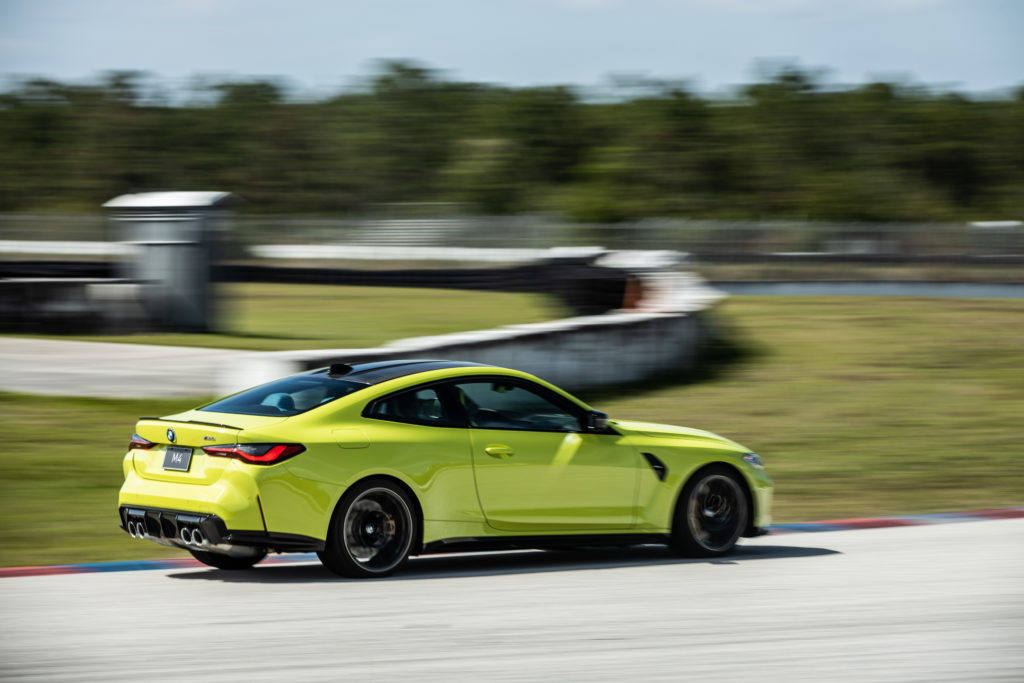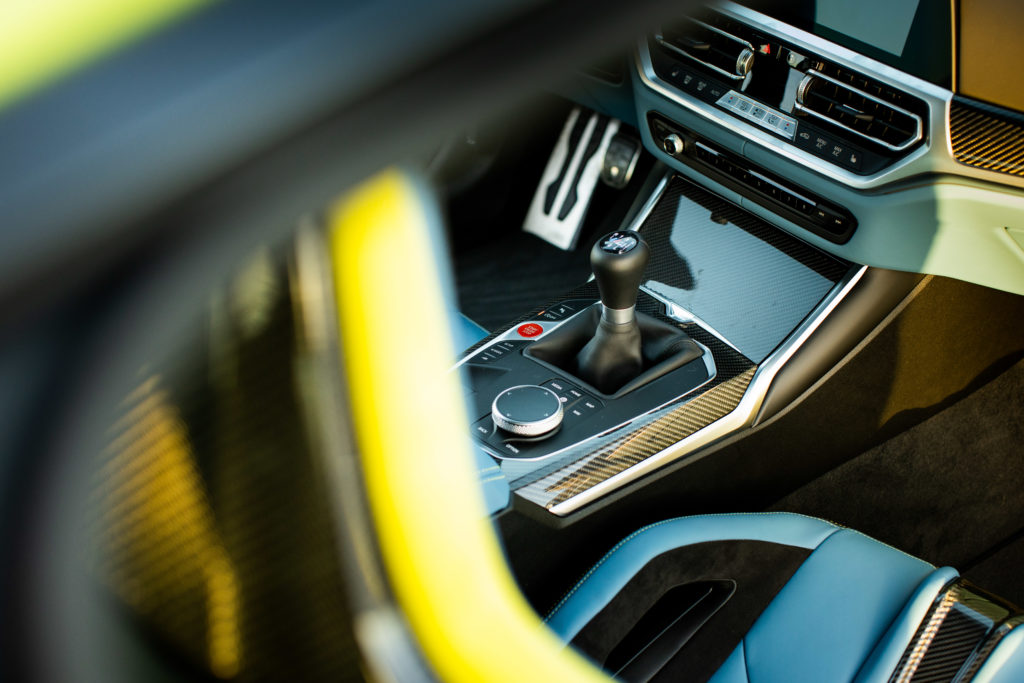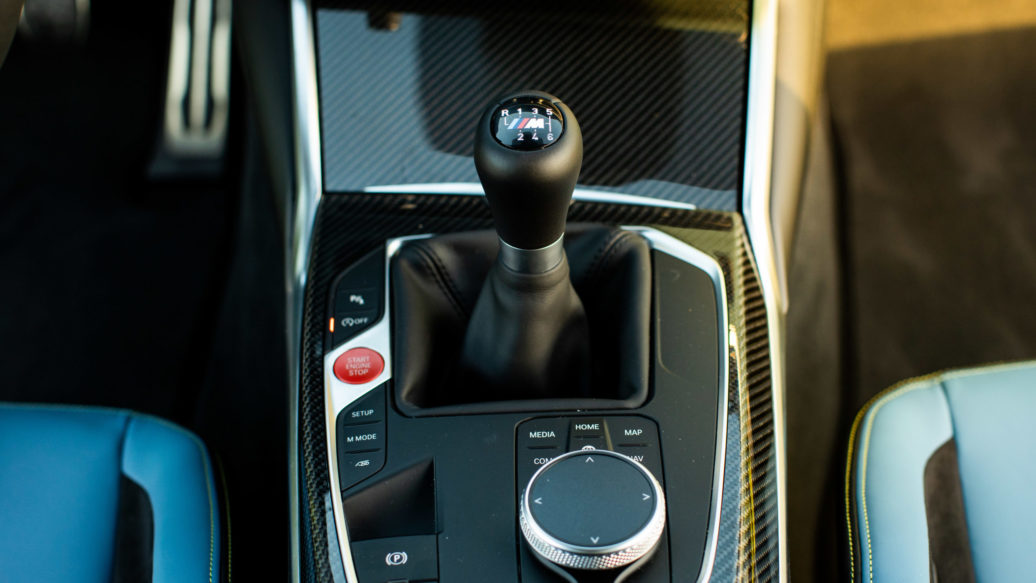Three weeks ago, for reasons that will be revealed this summer, I found myself at Palm Beach International Raceway staring down the new BMW M3 and M4, keys in hand. Following the lifted embargo since then, plenty of discussion (and lamentation) has been doled out online about the new pair and their intentionally bold front fascias—but despite these strong visual statements, I have another perspective: the legacy of the new M3 and M4 will be their drivetrain.
There’s always some circumstance and occasion to seeing a new M car in person for the first time, and the pair of Isle of Man Green and Sao Paulo Yellow M3s and M4s (both new race tracks making their way to the M color-naming portfolio) were my first for the new generation. As global automotive media has explained ad nauseam, the design of this pair departs from the G20 3 Series (and even the G22 4 Series, with its already-distinctive kidney grilles). They’re wider and punchier than their MPA siblings—that’s BMW-speak for M Performance Automobiles—and unique in ways that an aftermarket tune and eBay M badge won’t be able to replicate.
And no amount of upgrades to an M440i will be able to replicate the manual transmission, either.
Call it sacrilege, but I’ve never felt that every vehicle needs to be a manual. Sure, there are some cars that could have benefited from them (the A90 Toyota Supra and BMW Z4 M40i twins, for two recent examples), but there are also cars that got a stick shift when it really wasn’t necessary. My old factory-manual Mercedes W124 300E comes to mind here, or the three-liter E53 X5 with its crawler first gear (yes, that’s going to ruffle some feathers). But the reality is that rare doesn’t always mean better; I’d rather see a transmission that coexists with the engine and the chassis, whether that means shifting by hand or letting the machine decide.
This is not to say that I haven’t been wrong before, however. After the Pittsburgh Vintage Grand Prix in 2014, I wrote a piece that was picked up by another automotive outlet about how the then-new F82 M4 felt like it was built around the DCT, and would feel strange with a manual. Having put a couple of thousand miles on M4s since then, I’ve come to retract that argument—although I still wouldn’t kick a DCT out of the garage.

The new generation, though, is a different story. Yes, there’s still a brilliantly-engaging automatic option, complete with shift lights and intuitive, lightning-fast paddle changes, but that’s not the star of this show. Against considerable odds (and years of on-again, off-again teasing) BMW has managed to fit a spectacular manual transmission to the latest M3 and M4, and its inclusion is an engineering statement that doesn’t deserve to be lost among a thousand conversations about bodywork. It’s not just the fact that a manual exists in this car, it’s the fact that it’s actually good.
Most modern manuals tend to be computerized, with protections in place both to protect the equipment and to assist with smoother shifts. The M3 has these features, too, but in its programmable M2 mode, you have the ability to turn off some of these safeties. The combination of aggressive throttle-mapping and fully manual rev-matching make the new car an old-school thrill, and on the long sweepers and straights of PBIR, the potent S58 and true manual gearbox make this car a weapon to be conquered.

The shifts are clean and precise, too. Long gone are the days of lightweight shift knobs and wandering bushings; this shifter rests perfectly in your hand and drops into gear with a solid thunk. It’s surprisingly accessible among the iDrive controls and buttons of the modern interior, too. Sure, it looks odd surrounded by so many alien-looking controls, but from the driver’s seat, everything is right where you remember it being.
You’ll remember more than just placement, though. This transmission is a six-speed, unlike the seven-speed in some competitors’ offerings. But besides just saving development costs, six is the right number of gears for this car, allowing for long pulls in each gear and a familiar driving experience around a track—albeit much, much faster than the previous six generations of the M3.
Yes, there are caveats. The manual is available on the “core” model only, with 473 horsepower in comparison to the Competition’s 503. And yes, this is still a wildly expensive car, starting around $70,000 and rising to $90,000 quickly with the options you’ll want. But for a manual driving experience with a muscular motor, it’s still the most useable—and customizable—choice by far. From the BMW Individual paint catalog, to the dramatic carbon bucket seats, carbon-fiber roof, and carbon-fiber accents, if you’ve been waiting years to build your dream manual M3, I can assure you that 30 missing horsepower won’t detract from the experience—and having an exclusively rear-wheel-drive sport sedan will only make it more exquisite.

As for the rumors that this is the last manual M3, I’m not so sure. There are roughly thirty cars in the U.S. market that currently offer manual transmissions, and while two of them are the M3 and M4, it’s a lively segment; nearby on the list are the Porsche 718 Boxster and Cayman, the Chevrolet Camaro and Ford Mustang, and BMW’s own (sold-out) M2 CS. As we know, competition breeds innovation—or imitation, as the case may be.
So perhaps the manual transmission arms race will continue, as long as drivers with means vote with their wallets. Fortunately, BMW has given us six good reasons to do just that.—David Rose
[Photos by Sam Cobb for BMW of North America.]





















